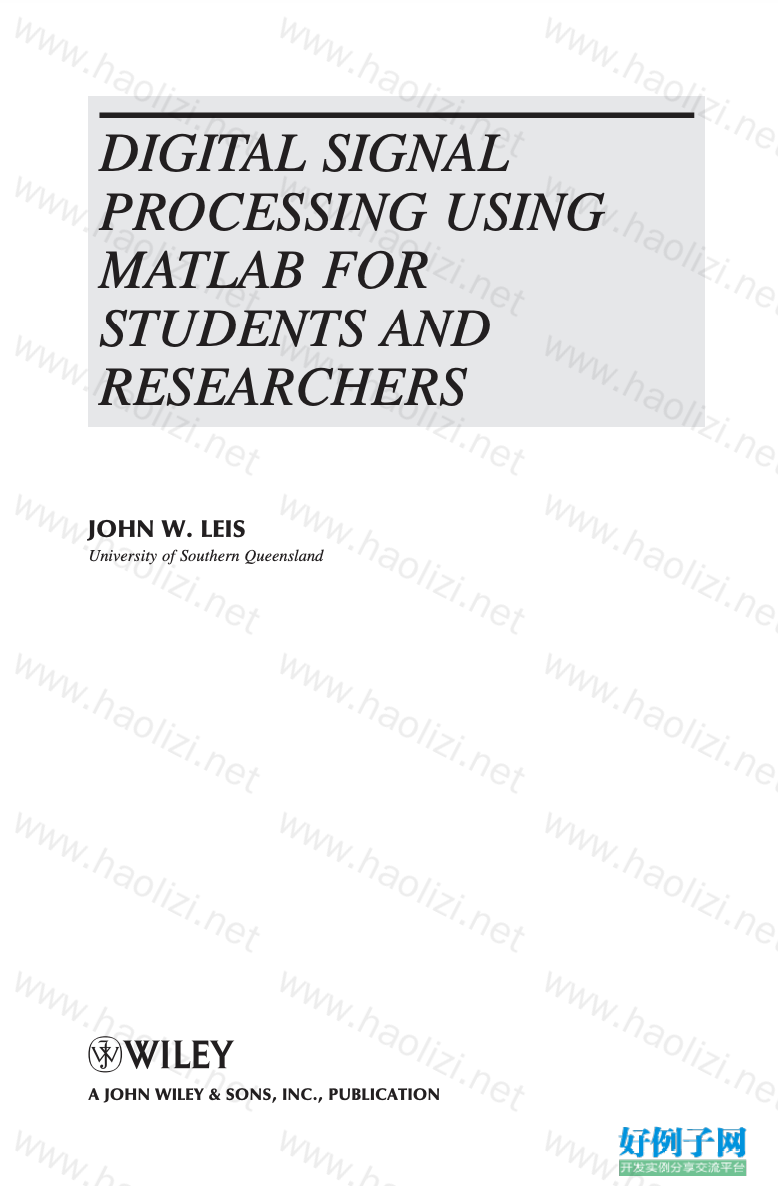实例介绍
【实例简介】:Digital_Signal_Processing_Using_MATLAB for students and Researchers
【实例截图】

【核心代码】
CONTENTS PREFACE XI CHAPTER 1 WHAT IS SIGNAL PROCESSING? 1 1.1 Chapter Objectives 1 1.2 Introduction 1 1.3 Book Objectives 2 1.4 DSP and ITS Applications 3 1.5 Application Case Studies Using DSP 4 1.6 Overview of Learning Objectives 12 1.7 Conventions Used in This Book 15 1.8 Chapter Summary 16 CHAPTER 2 MATLAB FOR SIGNAL PROCESSING 19 2.1 Chapter Objectives 19 2.2 Introduction 19 2.3 What Is MATLAB? 19 2.4 Getting Started 20 2.5 Everything Is a Matrix 20 2.6 Interactive Use 21 2.7 Testing and Looping 23 2.8 Functions and Variables 25 2.9 Plotting and Graphing 30 2.10 Loading and Saving Data 31 2.11 Multidimensional Arrays 35 2.12 Bitwise Operators 37 2.13 Vectorizing Code 38 2.14 Using MATLAB for Processing Signals 40 2.15 Chapter Summary 43 CHAPTER 3 SAMPLED SIGNALS AND DIGITAL PROCESSING 45 3.1 Chapter Objectives 45 3.2 Introduction 45 3.3 Processing Signals Using Computer Algorithms 45 3.4 Digital Representation of Numbers 47 3.5 Sampling 61 3.6 Quantization 64 3.7 Image Display 74 3.8 Aliasing 81 3.9 Reconstruction 84 3.10 Block Diagrams and Difference Equations 88 ftoc.indd vii toc.indd vii 4/13/2011 5:26:03 PM /13/2011 5:26:03 PM viii CONTENTS 3.11 Linearity, Superposition, and Time Invariance 92 3.12 Practical Issues and Computational Effi ciency 95 3.13 Chapter Summary 98 CHAPTER 4 RANDOM SIGNALS 103 4.1 Chapter Objectives 103 4.2 Introduction 103 4.3 Random and Deterministic Signals 103 4.4 Random Number Generation 105 4.5 Statistical Parameters 106 4.6 Probability Functions 108 4.7 Common Distributions 112 4.8 Continuous and Discrete Variables 114 4.9 Signal Characterization 116 4.10 Histogram Operators 117 4.11 Median Filters 122 4.12 Chapter Summary 125 CHAPTER 5 REPRESENTING SIGNALS AND SYSTEMS 127 5.1 Chapter Objectives 127 5.2 Introduction 127 5.3 Discrete-Time Waveform Generation 127 5.4 The z Transform 137 5.5 Polynomial Approach 144 5.6 Poles, Zeros, and Stability 146 5.7 Transfer Functions and Frequency Response 152 5.8 Vector Interpretation of Frequency Response 153 5.9 Convolution 156 5.10 Chapter Summary 160 CHAPTER 6 TEMPORAL AND SPATIAL SIGNAL PROCESSING 165 6.1 Chapter Objectives 165 6.2 Introduction 165 6.3 Correlation 165 6.4 Linear Prediction 177 6.5 Noise Estimation and Optimal Filtering 183 6.6 Tomography 188 6.7 Chapter Summary 201 CHAPTER 7 FREQUENCY ANALYSIS OF SIGNALS 203 7.1 Chapter Objectives 203 7.2 Introduction 203 7.3 Fourier Series 203 7.4 How Do the Fourier Series Coeffi cient Equations Come About? 209 7.5 Phase-Shifted Waveforms 211 7.6 The Fourier Transform 212 7.7 Aliasing in Discrete-Time Sampling 231 7.8 The FFT as a Sample Interpolator 233 ftoc.indd viii toc.indd viii 4/13/2011 5:26:03 PM /13/2011 5:26:03 PM CONTENTS ix 7.9 Sampling a Signal over a Finite Time Window 236 7.10 Time-Frequency Distributions 240 7.11 Buffering and Windowing 241 7.12 The FFT 243 7.13 The DCT 252 7.14 Chapter Summary 266 CHAPTER 8 DISCRETE-TIME FILTERS 271 8.1 Chapter Objectives 271 8.2 Introduction 271 8.3 What Do We Mean by “Filtering”? 272 8.4 Filter Specifi cation, Design, and Implementation 274 8.5 Filter Responses 282 8.6 Nonrecursive Filter Design 285 8.7 Ideal Reconstruction Filter 293 8.8 Filters with Linear Phase 294 8.9 Fast Algorithms for Filtering, Convolution, and Correlation 298 8.10 Chapter Summary 311 CHAPTER 9 RECURSIVE FILTERS 315 9.1 Chapter Objectives 315 9.2 Introduction 315 9.3 Essential Analog System Theory 319 9.4 Continuous-Time Recursive Filters 326 9.5 Comparing Continuous-Time Filters 339 9.6 Converting Continuous-Time Filters to Discrete Filters 340 9.7 Scaling and Transformation of Continuous Filters 361 9.8 Summary of Digital Filter Design via Analog Approximation 371 9.9 Chapter Summary 372 BIBLIOGRAPHY 375 INDEX 379
Digital_Signal_Processing_Using_MATLAB for students and Researchers
好例子网口号:伸出你的我的手 — 分享!
小贴士
感谢您为本站写下的评论,您的评论对其它用户来说具有重要的参考价值,所以请认真填写。
- 类似“顶”、“沙发”之类没有营养的文字,对勤劳贡献的楼主来说是令人沮丧的反馈信息。
- 相信您也不想看到一排文字/表情墙,所以请不要反馈意义不大的重复字符,也请尽量不要纯表情的回复。
- 提问之前请再仔细看一遍楼主的说明,或许是您遗漏了。
- 请勿到处挖坑绊人、招贴广告。既占空间让人厌烦,又没人会搭理,于人于己都无利。
关于好例子网
本站旨在为广大IT学习爱好者提供一个非营利性互相学习交流分享平台。本站所有资源都可以被免费获取学习研究。本站资源来自网友分享,对搜索内容的合法性不具有预见性、识别性、控制性,仅供学习研究,请务必在下载后24小时内给予删除,不得用于其他任何用途,否则后果自负。基于互联网的特殊性,平台无法对用户传输的作品、信息、内容的权属或合法性、安全性、合规性、真实性、科学性、完整权、有效性等进行实质审查;无论平台是否已进行审查,用户均应自行承担因其传输的作品、信息、内容而可能或已经产生的侵权或权属纠纷等法律责任。本站所有资源不代表本站的观点或立场,基于网友分享,根据中国法律《信息网络传播权保护条例》第二十二与二十三条之规定,若资源存在侵权或相关问题请联系本站客服人员,点此联系我们。关于更多版权及免责申明参见 版权及免责申明



网友评论
我要评论